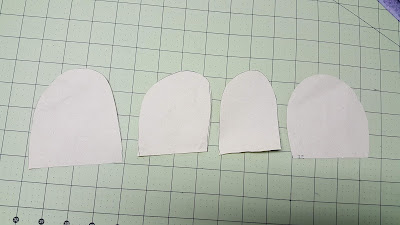Leslie Stobbart here with the November BOM design.
The block that we'll be making for our monthly block lotto is a traditional quilt block design I'm calling "Vintage Triangles." I'm sure there's an official name for this block, but I don't know it. (If you do know the name, please share! I'd love to have an actual title for this beauty!) called Old Maid's Puzzle. Thank you to Brenda for finding the correct name for this block!
Our block design is inspired by a photo of a vintage quilt that Annabel Wrigley (@littlepincushionstudio) posted on Instagram on August 2, 2021. Remember when she came and did a workshop in person for our guild in January 2020? Remember in-person workshops?? 😭😭😭
She bought this quilt at an antique mall for $25, which is an excellent deal! What a lucky quilt.
I saw this photo on Instagram and immediately saved it in my "BOM Ideas" folder. So today's the day we get to make it!
Colour Choices:
Maker's choice!
Blocks can be made with any two fabrics of your choice, as long as there's some contrast between the two. Solids, prints, linens, voiles, whatever your heart desires! I think this pattern is going to look great with a mix.
Cutting and Construction:
All seam allowances are 1/4" for this pattern
Completed blocks will measure 14" (unfinished)
For each block you'll need to have:
- 6 HSTs (half-square triangles) that measure 5" x 5" made from both fabrics
- 3 squares cut to 5" x 5" from the lighter (in colour, not weight) of the 2 fabrics
You can refer to an HST tutorial to help you make multiple half-square triangles in one go. I really like the two-at-a-time HST method, personally. I found a great tutorial blog post from Blossom Heart Quilts if you want to refresh/learn this technique.
The finished size for these HSTs will be 4.5", so if you're doing the two-at-a-time method, and you want to end up with minimal trimming once you cut the two HSTs apart, you would start with one square of each fabric cut to 5 3/8". If less than a 1/4" measurement makes you sweaty, you can always cut your two starting squares to be 5 1/2" and then trim the HSTs down to 5" once you've done the sewn the two seams and cut the two units apart. You're your own boss!
So, after you’ve got your solid blocks and HST units cut and sewn, arrange them as below:
However, if you miss the nesting, it's actually *not* a big deal. I find that perfect points feel very important in the moment when you're sewing them, but then they're not actually that important once the quilt top has been made and quilted and washed and it's winged over the back of your couch or your kid has had it on their bed while they're potty training (woopsie!). But perfect points ARE satisfying in the moment and I don't want to deny you that moment of joy, if perfection is your thing.
So there you have it! Vintage Triangles! Old Maid's Puzzles! I think these are going to look so great in a mix of all of our fabrics, and because they're a fairly large block, we may get enough entries to allow for two draws in January.
Thanks as always for participating in this activity. I'm looking forward to seeing everyone's blocks at the January 2022(?!) meeting.






















































